Javan Rhinos
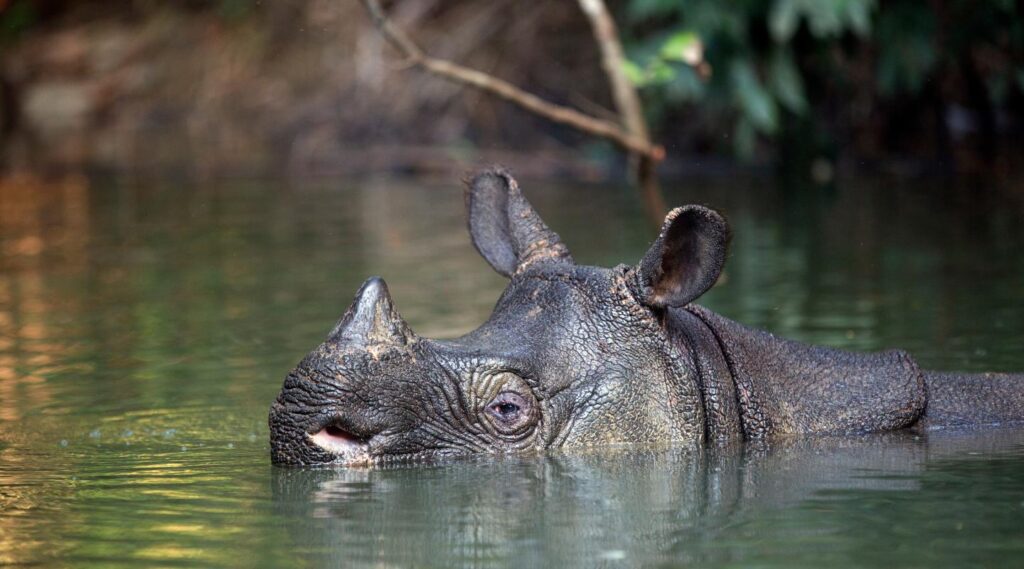
The Javan rhinoceros stands as one of the rarest large mammals on Earth, teetering on the precipice of extinction. These elusive creatures now exist only in a single population of approximately 76 individuals, confined to the lush forests of Ujung Kulon National Park on the island of Java, Indonesia. Their historical range once spanned vast areas of Southeast Asia, including parts of India, Bangladesh, Myanmar, Thailand, and Vietnam. However, over the past century, their territory has dramatically shrunk due to relentless poaching and widespread habitat destruction.
As the smallest of the five rhinoceros species, the Javan rhino cuts a distinctive figure in the animal kingdom. Standing between 4.6 to 5.8 feet tall at the shoulder and weighing anywhere from 1,984 to 5,071 pounds, these creatures possess a unique charm. Their most notable feature is a single horn that can grow up to 10 inches long, though it’s primarily the males who develop prominent horns. The rhino’s skin is characterized by a series of loose folds, giving them an armored appearance reminiscent of their close relative, the greater one-horned rhinoceros.
These solitary animals make their home in the dense, tropical forests of Java, where they browse on a diverse array of plant species. Javan rhinos are remarkably adaptable in their dietary habits, with over 300 different plant species identified as part of their menu. Their role in the ecosystem is crucial, as they act as a keystone species, shaping the landscape through their feeding patterns and movements. The rhinos’ wallowing behavior creates muddy depressions that serve as microhabitats for other species, while their dung plays a vital role in seed dispersal and nutrient distribution throughout the forest.
The primary threats facing the Javan rhinoceros are twofold: their extremely small population size and their limited habitat. With only a single population remaining, these rhinos are highly vulnerable to disease outbreaks, natural disasters, and genetic bottlenecks. The invasive Arenga palm in Ujung Kulon National Park has emerged as a significant concern, outcompeting the rhinos’ food plants and reducing available habitat. Climate change looms as an additional threat, with rising sea levels potentially inundating parts of the low-lying national park that the rhinos call home.
Conservation efforts for the Javan rhino are multifaceted and intense, focusing on protecting their remaining habitat and closely monitoring the population. Anti-poaching patrols form a crucial line of defense, while camera traps and genetic studies provide valuable data for conservation strategies. Ongoing efforts to remove invasive Arenga palms and improve habitat quality within Ujung Kulon National Park are also underway. Some conservationists advocate for the establishment of a second population in a suitable location to mitigate the risk of extinction from a single catastrophic event.
Despite the numerous challenges, there is a glimmer of hope for the Javan rhino’s future. The population in Ujung Kulon has shown slight growth in recent years, a testament to the dedication and effectiveness of conservation efforts. The successful recovery of other rhino species, such as the greater one-horned rhino, provides a blueprint for saving their Javan cousins. However, the path forward requires continued international cooperation, substantial funding, and unwavering public support to ensure the long-term survival of this unique and ancient species. The fate of the Javan rhinoceros hangs in the balance, and our actions in the coming years will determine whether these magnificent creatures will continue to roam the Earth or fade into the annals of natural history.
Amur Leopard
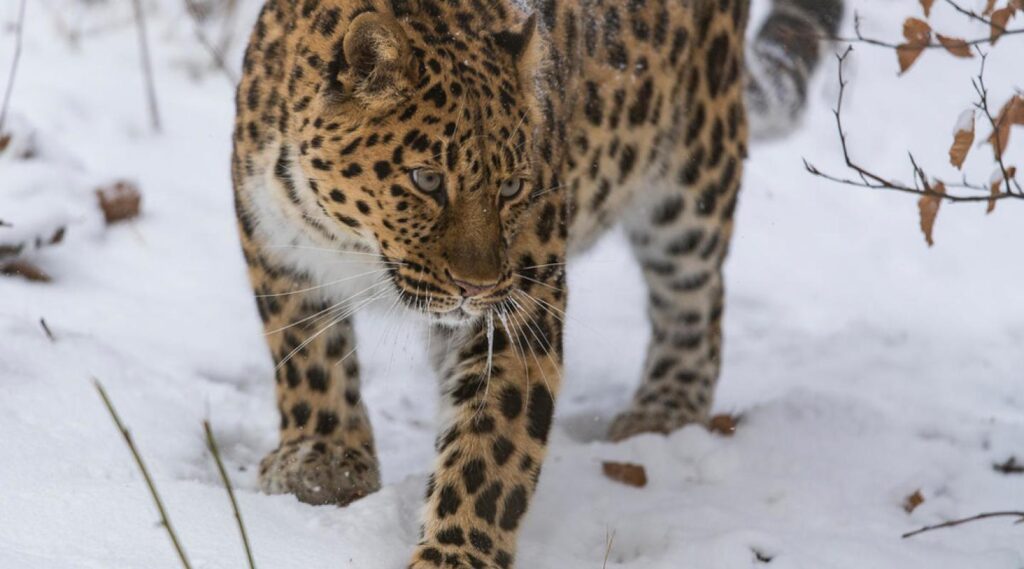
The Amur leopard, scientifically known as Panthera pardus orientalis, is one of the world’s most critically endangered big cats. These majestic creatures inhabit the temperate forests of the Russian Far East and adjacent areas of northeastern China, where they have adapted to survive in harsh, cold climates. Their historical range once spanned much wider across Southeast Asia, but human activity has dramatically reduced their habitat over the past century.
Physically, Amur leopards are distinguished by their pale coat adorned with widely-spaced rosettes, an adaptation that provides excellent camouflage in snowy environments. Their fur can grow up to 7 cm long in winter, allowing them to withstand freezing temperatures. These powerful cats weigh between 70-105 pounds and are capable of incredible feats of agility, running at speeds up to 37 miles per hour and leaping up to 19 feet horizontally.
The population of Amur leopards has teetered on the brink of extinction for decades. In the 1970s, their numbers had dwindled to fewer than 30 individuals in the wild. Thanks to concerted conservation efforts, recent estimates suggest a slight increase, with approximately 100 Amur leopards now living in their natural habitat. While this represents a glimmer of hope, the species remains critically endangered and faces numerous threats to its survival.
Amur leopards are solitary and territorial creatures, with individuals occupying large home ranges up to 100 square kilometers. They are primarily active during the day and at twilight, coinciding with the activity patterns of their prey. These big cats are skilled climbers and often drag their kills into trees to protect them from scavengers. Their diet consists mainly of roe deer, sika deer, musk deer, and wild boar, though they also hunt smaller animals like hares and badgers when larger prey is scarce.
The primary threats facing Amur leopards are habitat loss and fragmentation due to logging, development, and forest fires. Poaching for their beautiful fur remains a significant concern, as does the decline in prey populations. The small size of the Amur leopard population also puts them at risk of inbreeding depression, which can lead to reduced genetic diversity and increased susceptibility to diseases.
Conservation efforts for the Amur leopard have intensified in recent years, offering hope for the species’ survival. These initiatives include the establishment of protected areas like Land of the Leopard National Park in Russia, implementation of anti-poaching measures, and habitat restoration projects. Captive breeding programs play a crucial role in maintaining genetic diversity, and recent reintroduction efforts aim to establish new wild populations. While the future of the Amur leopard remains uncertain, the slight increase in their numbers demonstrates that dedicated conservation work can make a difference in saving this magnificent species from extinction.
Sunda Island Tiger
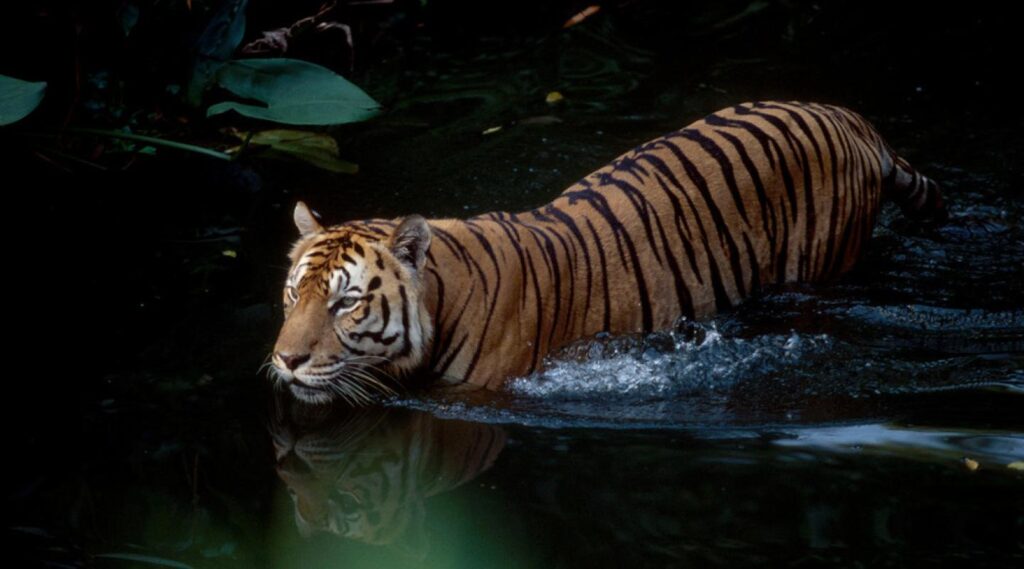
The Sunda Island Tiger, more commonly known as the Sumatran tiger, is a critically endangered subspecies of tiger found exclusively on the Indonesian island of Sumatra. These magnificent big cats once roamed across several Sunda islands but are now confined to the lush tropical forests of Sumatra, having gone extinct in Java and Bali. Their habitat includes a variety of forest types, from lowland and mountain forests to freshwater swamp forests and peat swamps, showcasing their adaptability within the island’s diverse ecosystems.
As the smallest living tiger subspecies, Sumatran tigers possess unique physical characteristics that set them apart from their continental cousins. Their coat is a darker shade of orange, adorned with thicker, more closely spaced black stripes – an adaptation that provides excellent camouflage in the dense, shadowy forests they call home. Male Sumatran tigers typically weigh between 165 and 308 pounds, with females being slightly smaller, reflecting their evolutionary adaptation to the island’s environment and available prey.
The population status of the Sumatran tiger is dire, with fewer than 400 individuals estimated to remain in the wild. Some conservationists suggest the number could be as low as 300-350 tigers. This small population is fragmented across Sumatra, with the largest concentration found in Kerinci Seblat National Park. The fragmentation of their population poses significant challenges for genetic diversity and long-term survival of the subspecies.
The primary threats facing Sumatran tigers are multifaceted and largely human-driven. Habitat loss and fragmentation due to deforestation, particularly for the establishment of palm oil plantations, have dramatically reduced the tigers’ available territory. Poaching for the illegal wildlife trade remains a persistent threat, with tiger bones and other body parts fetching high prices on black markets. As their habitat shrinks, human-wildlife conflict has increased, leading to retaliatory killings when tigers come into contact with human settlements and livestock.
Conservation efforts for the Sumatran tiger are ongoing and multifaceted. These initiatives include the establishment and protection of national parks and wildlife reserves, which provide crucial safe havens for the tigers. Anti-poaching patrols and strengthened law enforcement aim to combat illegal hunting and trade. Habitat restoration projects seek to reconnect fragmented forest areas, while community engagement programs work to reduce human-tiger conflicts and foster local support for conservation.
Despite the challenges, there is still hope for the Sumatran tiger. Dedicated conservation efforts, including advanced monitoring techniques like camera traps and genetic studies, are providing valuable data to inform protection strategies. The survival of this unique subspecies is crucial not only for its own sake but also for maintaining the biodiversity and ecological balance of Sumatra’s forests. As conservationists and local communities continue to work together, there remains a chance to secure a future for these remarkable big cats in their island home.
Mountain Gorillas
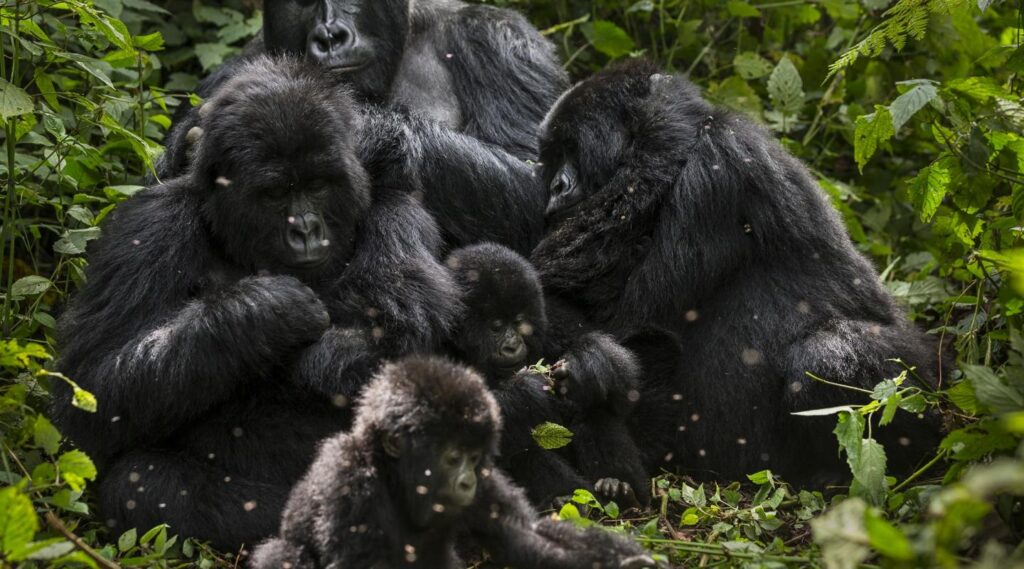
The mountain gorilla (Gorilla beringei beringei) is one of the most critically endangered primates on Earth, with only about 1,063 individuals remaining in the wild as of 2024. These magnificent creatures inhabit the mountainous regions spanning the borders of Rwanda, Uganda, and the Democratic Republic of Congo, living in the Virunga Mountains and Bwindi Impenetrable National Park.
Mountain gorillas are distinguished by their thick, long fur, which helps them survive in their high-altitude habitat where temperatures can often drop below freezing. They are slightly larger than their lowland cousins and have shorter arms. Their social structure revolves around family groups led by a dominant silverback male, who organizes troop activities and protects the group from threats.
The diet of mountain gorillas consists primarily of vegetation, including leaves, shoots, stems, and occasionally fruits. They spend a significant portion of their day foraging and eating, as their large bodies require substantial amounts of food. Mountain gorillas are generally peaceful animals, but silverbacks can display impressive shows of strength when defending their group, including chest-beating, aggressive charges, and intimidating roars.
Conservation efforts have played a crucial role in the survival of mountain gorillas. Their population has shown a promising increase in recent years, growing from an estimated 620 individuals in 1989 to over 1,000 today. This success is largely due to intensive protection measures, including daily monitoring by dedicated tracker teams, anti-poaching patrols, and veterinary interventions when necessary.
Despite these conservation successes, mountain gorillas continue to face significant threats. Habitat loss due to human encroachment, poaching, and the risk of disease transmission from humans remain ongoing challenges. Climate change also poses a potential threat, as it may affect the gorillas’ high-altitude forest habitat.
The survival of mountain gorillas is not only important for biodiversity conservation but also for the local communities and economies. Gorilla tourism has become a significant source of income for countries like Rwanda and Uganda, providing an economic incentive for their protection. However, this also requires careful management to balance the benefits of tourism with the need to minimize human impact on these vulnerable populations.
Tapanuli Orangutan
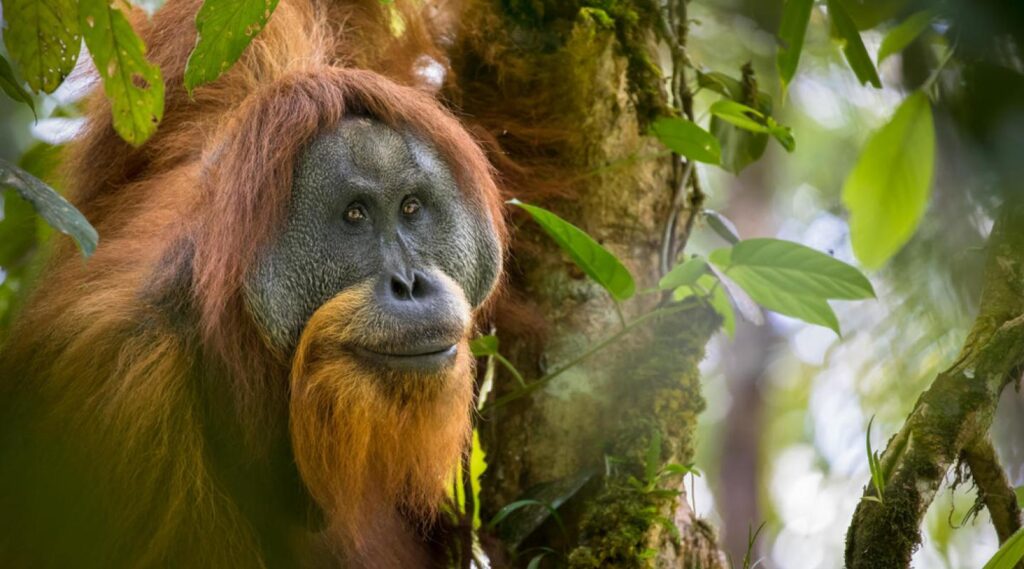
The Tapanuli orangutan (Pongo tapanuliensis) is the most recently discovered and critically endangered species of great ape. Identified as a distinct species in 2017, these orangutans are found exclusively in the Batang Toru forest ecosystem of North Sumatra, Indonesia. With fewer than 800 individuals remaining in the wild, they are considered the rarest and most threatened of all great apes.
Physically, Tapanuli orangutans share similarities with both Sumatran and Bornean orangutans but have some unique characteristics. They are slightly smaller in size compared to their cousins, with males having smaller cheek pouches than Bornean orangutans. Their hair is frizzier, and they have smaller heads and flatter faces compared to Sumatran orangutans. These features, along with genetic analysis, led to their classification as a separate species.
The habitat of Tapanuli orangutans is restricted to about 1,000 square kilometers of tropical and subtropical moist broadleaf forests, ranging from elevations of 300 to 1,300 meters. This limited range makes them particularly vulnerable to habitat loss and fragmentation. Their population is believed to have declined by 83% over three generations, primarily due to human activities such as deforestation, hunting, and conflict with local communities.
Conservation efforts for Tapanuli orangutans face significant challenges. The primary threats include habitat destruction for small-scale agriculture, mining, and a proposed hydroelectric dam project that could impact up to 10% of their remaining habitat. These pressures, combined with their small population size, put them at high risk of inbreeding depression and make them extremely susceptible to extinction.
Despite these challenges, there are ongoing conservation initiatives aimed at protecting the Tapanuli orangutan. These include the establishment of protected areas, anti-poaching patrols, habitat restoration projects, and community engagement programs to reduce human-wildlife conflict. Researchers and conservationists are also working to better understand the species’ ecology and behavior to inform more effective protection strategies.
The survival of the Tapanuli orangutan is crucial not only for biodiversity conservation but also for the local ecosystem and communities. As a keystone species, these orangutans play a vital role in seed dispersal and maintaining forest health. Their conservation also has potential economic benefits through sustainable ecotourism. However, saving this species will require coordinated efforts from local communities, government agencies, and international conservation organizations to address the complex challenges threatening their existence.
angtze Finless Porpoise
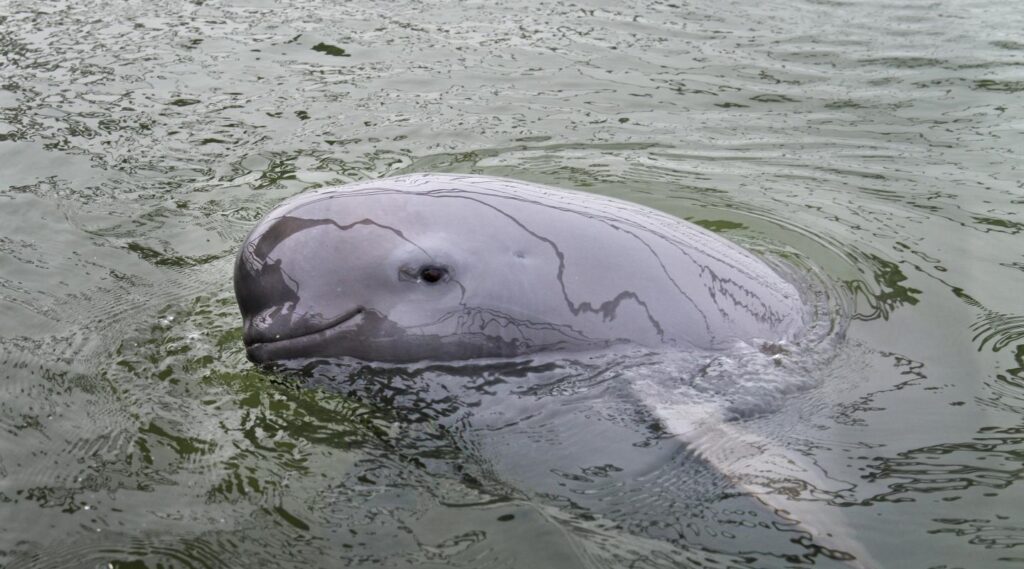
The Yangtze finless porpoise (Neophocaena asiaeorientalis) is a critically endangered species of toothed whale endemic to the Yangtze River in China. It is the country’s only known freshwater cetacean following the likely extinction of the baiji dolphin. These small porpoises are distinguished by their lack of a dorsal fin, rounded head, and dark grey coloration. They typically grow to about 1.5-1.9 meters in length and weigh up to 72 kilograms.
The habitat of the Yangtze finless porpoise is limited to the middle and lower reaches of the Yangtze River, from Yichang to Shanghai, and the adjoining Poyang and Dongting Lakes. They prefer shallow waters and are often found in oxbow lakes, river mouths, and tributary confluences. Their population has declined dramatically in recent decades, with current estimates suggesting fewer than 1,000 individuals remain in the wild.
The primary threats facing the Yangtze finless porpoise are human-induced. Overfishing has severely depleted their prey species, while water development projects have caused significant habitat loss and degradation. Water pollution from industrial and agricultural runoff poses a serious threat to their health. Additionally, accidental deaths caused by entanglement in fishing gear and collisions with motorized vessels contribute to their declining numbers.
Conservation efforts for the Yangtze finless porpoise include both in situ and ex situ measures. Several natural and semi-natural reserves have been established to protect their habitat. A notable success in ex situ conservation is the Tian’e-Zhou Semi-natural Reserve, where porpoises have been successfully introduced and are breeding naturally. Captive breeding programs have also shown promise, with the first freshwater cetaceans ever born in captivity occurring at the Institute of Hydrobiology of the Chinese Academy of Sciences.
Despite these conservation efforts, the Yangtze finless porpoise remains at high risk of extinction. The population continues to decline at an alarming rate, estimated at about 5% per year. Conservationists stress the urgent need for stronger protective measures, including stricter regulation of fishing practices, reduction of water pollution, and mitigation of the impacts of water development projects.
The survival of the Yangtze finless porpoise is crucial not only for biodiversity conservation but also for the health of the Yangtze River ecosystem. As a keystone species, these porpoises play a vital role in maintaining the ecological balance of their habitat. Their conservation also has potential economic benefits through sustainable ecotourism. However, saving this unique species will require coordinated efforts from local communities, government agencies, and international conservation organizations to address the complex challenges threatening their existence.
Black Rhinos
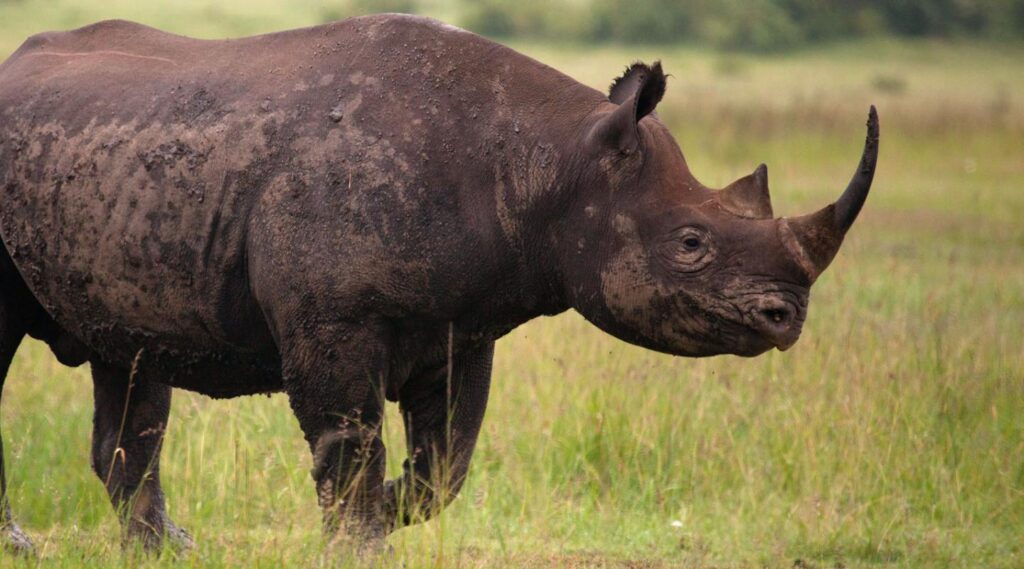
The black rhinoceros (Diceros bicornis) is one of the most critically endangered large mammals on Earth. Once widespread across sub-Saharan Africa, these magnificent creatures have suffered a dramatic decline in population due to rampant poaching and habitat loss. By the early 1990s, their numbers had plummeted to fewer than 2,500 individuals, representing a staggering 96% decrease from their population in 1960.
Physically, black rhinos are distinguished by their hooked upper lip, which adapts them for browsing on leaves, twigs, and branches. Despite their name, they are actually gray in color and can weigh between 1,760 to 3,080 pounds. Standing about 5.2 feet tall at the shoulder, these powerful animals possess two horns, with the front horn typically being longer and averaging around 19 inches in length.
Black rhinos are primarily solitary creatures, inhabiting a variety of habitats including savannas, woodlands, and semi-desert regions. They are browsers, meaning they feed on trees and bushes rather than grasses. Their diet consists of a wide range of plant species, with some individuals known to consume over 200 different types of plants. This diverse diet plays a crucial role in shaping their ecosystem, as their feeding habits help maintain the balance of vegetation in their habitats.
The greatest threat facing black rhinos is illegal poaching for their horns. Rhino horn is highly valued in some cultures for its perceived medicinal properties and as a status symbol, driving a lucrative illegal wildlife trade. Despite scientific evidence showing that rhino horn has no medicinal value, the demand persists, putting immense pressure on wild populations. Habitat loss due to human encroachment and agriculture also continues to be a significant challenge for black rhino conservation.
Conservation efforts have shown some success in recent years, with the population slowly recovering to over 6,000 individuals as of 2024. These efforts include intensive anti-poaching measures, habitat protection, and carefully managed translocation programs to establish new populations in secure areas. Some countries, like South Africa and Namibia, have seen notable increases in their black rhino populations due to these concerted conservation initiatives.
Despite these positive trends, the black rhinoceros remains critically endangered and faces an uncertain future. Continued international cooperation, stringent law enforcement against poaching, and community-based conservation programs are essential for the long-term survival of this iconic species. As keystone species in their ecosystems, the preservation of black rhinos is crucial not only for their own sake but also for maintaining the biodiversity and ecological balance of African landscapes.
African Forest Elephant

The African forest elephant (Loxodonta cyclotis) is a critically endangered species native to the dense tropical rainforests of West and Central Africa. Smaller than their savanna-dwelling cousins, forest elephants typically stand 8-10 feet tall at the shoulder and weigh 2-5 tons. They are characterized by their straight, downward-pointing tusks, rounded ears, and darker gray skin adapted for life in the shadowy forest understory.
As herbivores, forest elephants play a crucial role in shaping their ecosystem. Their diet consists primarily of fruits, leaves, bark, and other vegetation. As they move through the forest, they disperse seeds in their dung, earning them the nickname “mega-gardeners of the forest.” Studies have shown that forest elephants can disperse seeds up to 57 kilometers from their origin, far exceeding the capabilities of other forest animals. This seed dispersal is vital for maintaining the biodiversity and carbon storage capacity of African rainforests.
Forest elephants live in small family groups, typically consisting of a mother and her offspring. Adult males are often solitary, joining female groups only for mating. These elephants have a long gestation period of about 22 months, and females usually give birth to a single calf every 5-6 years. This slow reproductive rate makes the species particularly vulnerable to population declines.
The most significant threat to African forest elephants is poaching for their ivory. Between 2002 and 2011, the forest elephant population declined by an estimated 62%, with poaching accounting for much of this loss. Habitat loss and fragmentation due to deforestation, agriculture, and human development also pose serious threats to the species. As a result, forest elephants now occupy only about 25% of their historic range.
Conservation efforts for the African forest elephant focus on anti-poaching measures, habitat protection, and community-based conservation initiatives. Protected areas like Gabon’s Minkébé National Park and the Republic of Congo’s Nouabalé-Ndoki National Park provide crucial safe havens for remaining populations. Additionally, efforts to reduce demand for ivory in consumer countries are essential for the species’ long-term survival.
Recent research has highlighted the importance of forest elephants in climate change mitigation. By preferentially feeding on smaller trees, they promote the growth of larger, more carbon-dense trees. One study estimated that the loss of forest elephants in Central Africa’s rainforests could result in a 7% reduction in the region’s carbon storage capacity. This finding underscores the critical role these elephants play not only in maintaining forest ecosystems but also in global climate regulation.
Sumatran Orangutan

The Sumatran orangutan (Pongo abelii) is one of three species of orangutans and is critically endangered. Found only in the northern parts of the Indonesian island of Sumatra, these great apes are known for their distinctive reddish-orange fur and remarkable intelligence. They are highly arboreal, spending most of their lives in the trees of tropical rainforests, and are the largest tree-dwelling animals in the world.
Physically, Sumatran orangutans are slightly smaller and more slender than their Bornean counterparts. Adult males can grow up to 1.7 meters tall and weigh up to 90 kilograms, while females are considerably smaller, averaging 90 centimeters in height and 45 kilograms in weight. They have extraordinarily long arms, spanning up to 2.25 meters, which are perfectly adapted for their arboreal lifestyle. Their feet are also hand-like, with opposable big toes, allowing them to grip branches securely as they move through the forest canopy.
These primates are known for their high intelligence and problem-solving abilities. They have been observed using tools in the wild, such as using sticks to extract termites from mounds or leaves as makeshift umbrellas during rainstorms. Sumatran orangutans have also demonstrated the ability to learn and use human sign language in captivity, showcasing their cognitive capabilities. Their intelligence is further evidenced by their complex social behaviors and the cultural variations observed between different orangutan populations.
The Sumatran orangutan faces numerous threats, primarily due to human activities. Deforestation for palm oil plantations, logging, and other agricultural purposes has drastically reduced their natural habitat. This loss of forest not only diminishes their living space but also fragments their populations, making it difficult for orangutans to find food and mates. Additionally, the illegal pet trade continues to be a significant threat, with young orangutans often captured after their mothers are killed.
Conservation efforts for the Sumatran orangutan are ongoing but face significant challenges. Protected areas have been established, such as the Gunung Leuser National Park, which is part of the Tropical Rainforest Heritage of Sumatra UNESCO World Heritage Site. Rehabilitation centers work to rescue, rehabilitate, and when possible, reintroduce orangutans to the wild. However, the success of these efforts is limited by the continued loss of suitable habitat.
As of 2016, it was estimated that approximately 14,000 Sumatran orangutans remain in the wild, which is higher than previous estimates but still alarmingly low. Their survival is crucial not only for biodiversity but also for the health of Sumatra’s forests, as orangutans play a vital role in seed dispersal. Conservationists stress the need for stronger protection of existing forests, sustainable development practices, and increased public awareness to ensure the long-term survival of this critically endangered species.
Hawksbill Turtles
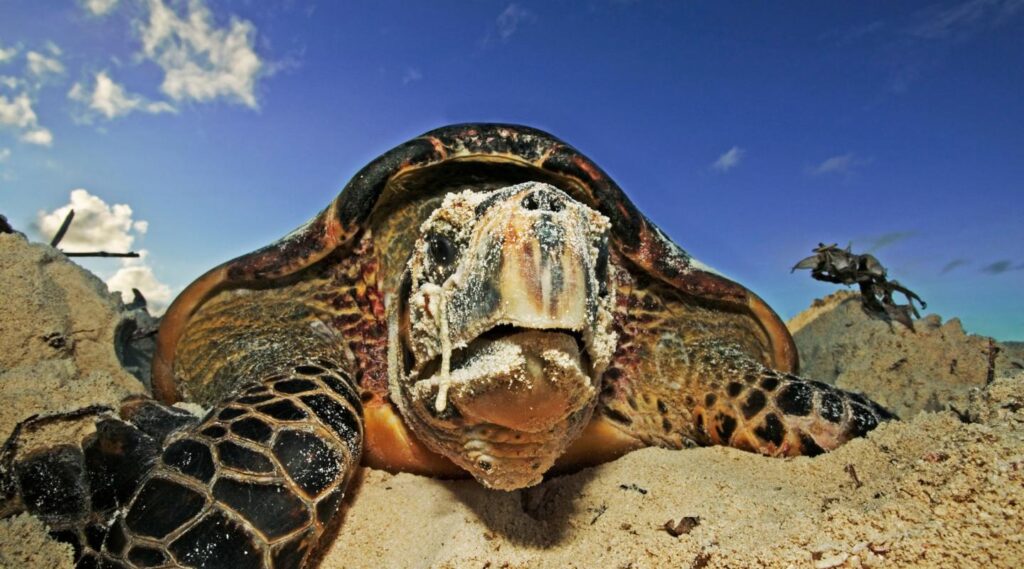
Hawksbill sea turtles (Eretmochelys imbricata) are critically endangered marine reptiles known for their distinctive hawk-like beaks and beautiful carapaces. These medium-sized turtles typically grow to about 1 meter in length and weigh between 45-70 kilograms. Their shells are characterized by overlapping scutes that create a serrated appearance along the edges, making them highly prized in the illegal wildlife trade for their “tortoiseshell” pattern.
Found in tropical and subtropical waters of the Atlantic, Pacific, and Indian Oceans, hawksbills play a crucial role in maintaining the health of coral reef ecosystems. They are primarily spongivores, with sponges constituting 70-95% of their diet. This dietary preference helps maintain the diversity of coral reefs by preventing sponges from outcompeting slow-growing corals. Hawksbills also consume other marine invertebrates, algae, and jellyfish, including the venomous Portuguese man-of-war.
The life cycle of hawksbill turtles is complex and spans decades. Females typically nest every 2-4 years, laying 3-6 clutches of eggs per season, with each clutch containing about 160 eggs. After an incubation period of around 60 days, hatchlings emerge and make their perilous journey to the sea. Hawksbills reach sexual maturity after approximately 20-30 years, and their total lifespan can exceed 50 years in the wild.
Hawksbill turtles face numerous threats throughout their lives, primarily due to human activities. The illegal trade in tortoiseshell remains a significant danger, despite international bans. Other major threats include habitat loss of nesting beaches and feeding grounds, accidental capture in fishing gear (bycatch), pollution, and climate change. Rising temperatures affect the sex ratios of hatchlings and can lead to the loss of nesting beaches due to sea-level rise.
Conservation efforts for hawksbill turtles are ongoing worldwide. These include protecting nesting beaches, implementing fishing gear modifications to reduce bycatch, and enforcing laws against the trade in turtle products. Community-based conservation programs, such as those in El Salvador led by organizations like ProCosta, have shown promising results. These initiatives involve local communities in nest protection, hatchling release, and awareness campaigns, demonstrating that human intervention can make a positive impact on hawksbill populations.
Despite the challenges, there is hope for hawksbill turtles. Some populations have shown signs of recovery thanks to dedicated conservation efforts. For example, in the Caribbean, long-term protection of nesting beaches has led to increases in nesting females in several locations. However, continued international cooperation, stringent law enforcement, and public awareness are crucial for the long-term survival of this species. As keystone species in coral reef ecosystems, the preservation of hawksbill turtles is vital not only for biodiversity but also for the health of our oceans and the communities that depend on them.





